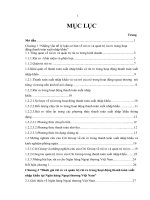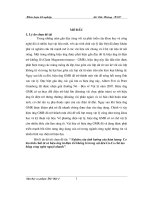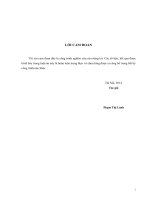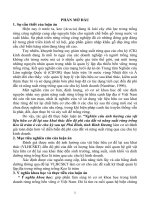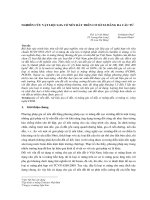Độ ẩm Thiệt hại trong Vật liệu gia cố bitum Fibre Road
Bạn đang xem bản rút gọn của tài liệu. Xem và tải ngay bản đầy đủ của tài liệu tại đây (169.98 KB, 11 trang )
Moisture Damage in Fibre-Reinforced Bituminous Road Materials
Ibrahim Kamaruddin and Madzlan Napiah
Universiti Teknologi PETRONAS, Seri Iskandar, Perak, Malaysia
Abstract
Water related damage in bituminous pavements is a major distress form in many South-east
Asian countries like Malaysia. Highway engineers acknowledge that stripping or loss of
adhesion between the aggregate surface and the bitumen film coating the aggregates and other
forms of moisture damage in bituminous pavements are shortening the pavement life as a result
of this damage. There is thus a need to evaluate the damage caused by water to pavements. The
use of the retained strength ratios obtained from laboratory moisture damage tests is a useful tool
in making quantitative predictions of the related damage caused by water. This study involved
laboratory work on the effect of water on the performance of bituminous mixtures. Comparisons
are made between the performance of Hot-rolled Asphalt (HRA) bituminous mixtures containing
a base bitumen of 50pen grade to that of a polymer-fibre reinforced HRA mixtures.
Keywords
Fibre-reinforced bituminous mix, stripping, tensile test, saturation, voids and porosity.
1. Introduction
The damaging effects of water on the physical properties and mechanical behaviour of
bituminous mixtures have been the focus of many studies. Many laboratory tests have been
developed in order to evaluate and quantify the amount of damage caused by water on
bituminous mixtures. The most widely used laboratory method in conducting these tests appear
to be the immersion-mechanical tests which measures the changes in mechanical properties of
the bituminous specimens after exposure to water. Typically the results are reported in terms of
percentage retained strength of the specimens. This paper is based on some laboratory work and
addresses the damaging effect of water in polymer fibre-reinforced bituminous mixtures.
2. Stripping in Bituminous Mixtures
The unfilled void spaces in compacted bituminous mixtures are able to hold sufficient quantities
of water that can cause distress and damage and reduce the mixture performance. The volume of
these voids varies depending on the nature of the voids, characteristics of the mix and the degree
to which they are compacted in the pavement (Lottman, 1982). The damaging effect of water
will give rise to stripping, de-bonding or loss of adhesion of the bitumen from the aggregate
surface. This is brought about by the loss of cohesion and softening of the binder due to the
action of the moisture within the bitumen or bituminous mix. Both stripping and softening can
occur in the same mixture.
Stripping is the physical separation of bitumen from the aggregate produced by the loss of
adhesion between the bitumen and the aggregate surface primarily due to the action of water or
water vapour. It is an aggregate interfacial phenomenon and induces the loss of stability in the
bituminous mixture that in turn promotes failure (Fromm, 1974). The phenomenon can be further
aggravated by the presence of aggregate surface coatings and by aggregates with a smooth
texture surface. Stripping is primarily an aggregate problem but that the type of bitumen used is
also important (Kennedy et. al, 1983). Softening is the general loss of stability of a bituminous
mixture that is brought about by a reduction in cohesion within the bituminous mix matrix due to
the action of water.
The resulting damage brought about by water can be assessed quantitatively by mechanical tests.
Properties such as loss of tensile strength or decrease of resilient and stiffness moduli have been
measured. Water induced damage is usually easy to identify when stripping is evident. Where a
loss of pavement stiffness or moduli occurs without the visual evidence of stripping, the cause of
the problem is less easily recognised.
There are a number of laboratory methods and tests that are cited in the literatures that enable the
determination of the moisture susceptibility and thus the proneness of bituminous mixtures to
stripping or de-bonding. Based on previous work (Tunnicliff and Root, 1983 and Gilmore et. al,
1983), it appears that vacuum saturation of the bituminous specimens followed by conditioning
and testing using the Indirect Tensile test show promise for introducing moisture into the
specimens and measuring their strength to predict the moisture susceptibility of the mixtures.
Specimens were moisture conditioned before the determination of their structural strengths as
those mixtures most susceptible to moisture damage would have the lowest structural strengths
following conditioning. The retained strength is determined by comparing the dry tensile
strength to the wet conditioned tensile strength of the bituminous mixtures.
3. Adhesion Properties of Bituminous Mixtures
Loss of adhesion is especially common in bituminous mixes which utilises hydrophilic
aggregates i.e. aggregates which have an affinity for water. An example of this type of aggregate
is granite which is widely used in road pavement construction in Malaysia. Ishai and Craus
(1977) listed two ways in which modifications are possible should the use of hydrophilic
aggregates prove to be unavoidable:
1. modification of the adhesion properties of the bitumen by additives
2. modification of the surface properties of the aggregates by treating them with cement-
water solution or hydrated lime-water solution.
Ishai and Craus (1977) also acknowledged that of the two modifications, the first is more useful
in asphalt paving technology. However, high quality additives are quite expensive in the mass
production of bituminous materials.
4. Materials Used in the Investigation
4.1 Mineral Aggregates, Filler and Bitumen
Limestone aggregates and Ordinary Portland cement (OPC) filler and a binder of nominal
penetration Grade 50 pen were used in the preparation of the Hot-Rolled Asphalt (HRA)
bituminous mixtures in this study. Some relevant properties of the material used are shown in
Table 1.
4. 2 Synthetic Fibres
Two types of synthetic fibres namely polypropylene and polyester were used in this study. The
fibres were used as a partial replacement of the filler; on an equal volume basis; at two
concentrations of 0.5% and 1% by weight of the mix. The fibres; in chopped form; were the by-
products of the textile industry and thus their potential use was desirable on environmental
grounds. Some characteristics of the fibres used are shown in Table 2.
Table 1: Properties of Mineral Aggregates, Filler and Bitumen
Material Percentage
by Weight
Relative
Density
Absorption
%
BS
Specification
Coarse
Aggregate
35 2.75 0.47 BS 594: Part
1: 1992 Table
3, Type F
Wearing
Course
designation
30/14
Sand
55
2.65
1.37
Filler
(Ordinary
Portland
Cement)
10
3.15
Penetration
(0.1 mm)
Softening
Point
(°C)
Penetration
Index, PI
Bitumen
52
48.5
-0.37
Table 2: Characteristics of Fibres Used in Study
Specific
Gravity
Denier Length
(mm)
Average
Diameter
(µ
µµ
µm)
Degradation
Temperatur
e
(°
°°
°C)
Polypropylene
(PP)
0.91 6 6 22* 160
Polyester (POL) 1.41 3 6 17* 250
*Values obtained from 20 readings using a light microscope at 400X magnifications.
The preparation of the bituminous samples in the laboratory is an energy intensive process. In
order to maintain thermal stability when using the polypropylene fibres, it was decided that the
mixing temperature when preparing the Hot Rolled Asphalt (HRA) mixture will not exceed
140°C and compaction be done at 130°C.
5. Wet-Dry Indirect Tensile Test
The wet-dry indirect tensile test was adopted as a principal measure of the bituminous mix
response to water damage. Most evaluations of water damage have been assessed quantitatively
by mechanical tests in which such properties as loss of tensile strength or decrease of resilient
and stiffness moduli have been measured. These are then given in the form of a tensile-strength
ratio and a modulus of elasticity ratio, for which the tensile strength and modulus of the dry
specimens served as references. The tensile strength ratio (TSR) and modulus of elasticity ratio
(MER) are dimensionless numbers used to represent the portion of tensile strength and modulus
retained following conditioning. Low values indicate high moisture damage. These ratios are
given as:
Tensile Strength Ratio (TSR)
dry
wet
ITS
ITS
TSR =
Modulus of Elasticity Ratio (MER)
dry
wet
MER
MER
MER =
Lottman (1982) used the static indirect tensile strength test to study the effect of water on
bituminous mixtures and recommended a minimum tensile strength ratio of 0.7 to differentiate
between a stripping and a non-stripping bituminous mix while Maupin (1982) reported values of
between 0.7-0.75. Ishai and Nesichi (1988) cited values of 60-75 percent retained stability values
for roads and highway pavements and 75 percent for airfield pavements as the quality criteria
used in Israel. Kennedy and Anagnos (1984) were also of the opinion that mixtures with less
than 70 percent retained strength are moisture susceptible and would require treatment before
being used as bituminous material.
6. Degree of Saturation
The degree of saturation gives a measure of the amount of water that is absorbed by the
specimen into its permeable voids. The degree of saturation is thus defined as the ratio of the
volume of water in the wet specimen to the total volume of voids in the specimen.
The creation of a degree of saturation in the laboratory high enough without damaging the
specimens and that the retained strength can be determined involves a moisture conditioning
process. Static soaking seems to provide ideal condition for stripping to occur while both
pressure and vacuum saturation procedures may create damage to the specimens. For practical
laboratory purposes however, static soaking may require too much time. Saturation by partial
vacuuming for short period of time has therefore been used in moisture damage studies on
bituminous mixtures. If the volume of absorbed water exceeds the volume of voids, the specimen
has been supersaturated and damage.
A number of researchers have come up with various regimes for vacuuming and saturating the
bituminous specimens. Lottman (1982) for example used 26-inches of mercury to vacuum the
specimens while lower levels of vacuuming (4 and 15-inches of mercury) have been cited in the
literature (Gilmore et. al, 1983, Graf, 1986). In addition to vacuuming, Lottman (1982) also
subjected the specimens to an advanced moisture conditioning in which thermal cycles or a cycle
of freezing-soaking was carried out. Ishai and Nesichi (1988) subjected the specimens to hot
water immersion (at 60°C) for up to 14 days and testing the specimens at different immersion
period to determine the retained strength of the specimens while Kennedy et. al. (1983) subjected
the specimens to the boiling test, a freeze-thaw cycle before conducting the indirect tensile test
on dry and conditioned specimens.
7. Void Structure in Bituminous Mixtures
The moisture conditioning process attempts to allow water to penetrate and occupy the air voids
in the specimen. An appreciation of the void structure in bituminous mixtures is thus very vital.
Kumar and Goetz (1977) conducted a laboratory study to examine the influence of asphalt film
thickness, voids and permeability on asphalt hardening in asphalt mixtures and came up with a
hypothetical model of the air voids system in a compacted bituminous mixture. Different water
saturation techniques were employed in their study that included a 24 hours soaking and
vacuuming at different absolute pressures. The model divides the air voids system into three
categories; through passage accessible air voids, dead end accessible air voids and non-
accessible air voids. The 24 hour soaking allows water to only occupy the through passage
accessible voids. The 24 hour soaking and hand pumping allowed the water to occupy the
through passage accessible voids as well as a small portion of the dead end accessible voids.
Vacuuming with an absolute pressure of 2.5cm mercury allowed the water to occupy the through
passage accessible voids and most of the dead end accessible voids. It is not possible for the
water to occupy the non-accessible voids unless the specimen is damaged in the process of
saturation. Therefore it is important in studies on water damage on bituminous mixtures to attain
a degree of saturation high enough without damaging the specimens to enable the retained
strength of the specimens to be determined.
8. Experimental Procedures
As the water susceptibility of the mixes was to be determined, the specimens were tested in both
the dry and wet condition. The dry conditioning involves curing the specimens at room
temperature for two days prior to testing. The wet conditioning involved subjecting the
bituminous samples to a combination of air vacuum, vacuum saturation and static soaking. Air
vacuuming is to evacuate all the accessible pores from air and water. The objective of vacuum
saturating the specimens was designed to accelerate the moisture damage process. It is extremely
important that the process of vacuum saturating the specimens do not result in a degree of
saturation greater than 100% which is indicative that more water was introduced into the voids
than there are void space, making comparison between samples no longer valid.
